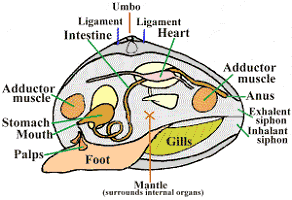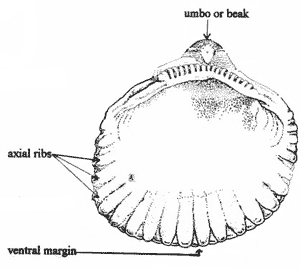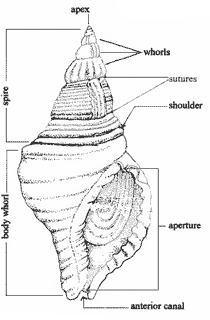|
| ||||||
|
Mollusk means soft-bodied. A mollusk has no internal skeleton but many have shells that act as an external skeleton, providing protection. Most mollusks usually have some version of a head, soft body, and foot. One important part of a mollusk's body is the mantle, which is the fleshy tissue that lines the inside of the shell. This part is responsible for shell growth and color, and it assists in other functions such as respiration. Growth of the shell occurs by the mantle absorbing calcium carbonate from the sea water. The color of the shell is due to pigment cells in the mantle. Most mollusks have a brownish "outer skin" called a periostracum while they are alive, which hides the beautiful colors and patterns of the shell. After the mollusk dies, the periostracum is lost and the shells surface is revealed. A dark shell that is found on the beach, quite often black, is an indication of either a fossilized specimen or one that has been buried in sediment for a long period of time. The phylum Mollusca is divided into seven classes, but only the two shell producing classes will be described here: Bivalvia and Gastropoda, which contain the univalves. Other classes include Aplacophora, Monoplacophora, Polyplacophora, Scaphophoda, and Cephalopoda. Please refer to the Conchologists of America mollusk page for more information on these other mollusk classes. (http://coa.acnatsci.org/conchnet/c-101a2.html)
Most bivalves have separate sexes, but some are hermaphrodites. Depending on the species, hermaphrodites may have both male and female organs at the same time, or they may switch sexes at different stages of their lives. Those with both organs usually release eggs and sperm at different times so they do not fertilize themselves, allowing for more genetic variation in the young. Most bivalves release eggs and sperm directly into the water, where fertilization takes place. The fertilized eggs hatch into young called larvae that swim with other microscopic animals in the plankton. The animal matures within several weeks and settles on the bottom to develop into an adult. The amount of time the young spend swimming differs by species, but the longer they swim, the better the chances the currents will carry them to new environments. Many young arrive at a location where they cannot survive because the habitat is unsuitable, but others find suitable habitats and are able to colonize new populations, which is important for the continuation of the species.
Gastropods do not rely on water circulation for food as bivalves do
because they have many structures that are used specifically for feeding.
Most gastropods are carnivores but some are herbivores, omnivores, and others are scavengers or detritivores. The head of a gastropod has a tubelike
extension called a proboscis, which includes a mouth and a tongue-like
strip of teeth, called a radula. Herbivores use the radula to scrape algae
off rocks, while carnivores use it to tear flesh or to drill holes in
shells to get to the meat inside. Fertilization of gastropod eggs occurs both inside and outside the body, depending on the species. Eggs are laid in either gelatinlike globs or in one of many types of egg capsules, which are sometimes mistaken for seaweed when washed up on shore. In some species, the eggs hatch into swimming young while others hatch into a crawling form that resemble the adults. Some species even bear live young! There are over 100,000 living species of mollusks worldwide with more than 1,000 species of shelled mollusks living in the Carolinas. Please read the conservation page to understand why shelled mollusks are important to us and what we can do to help them survive. |


